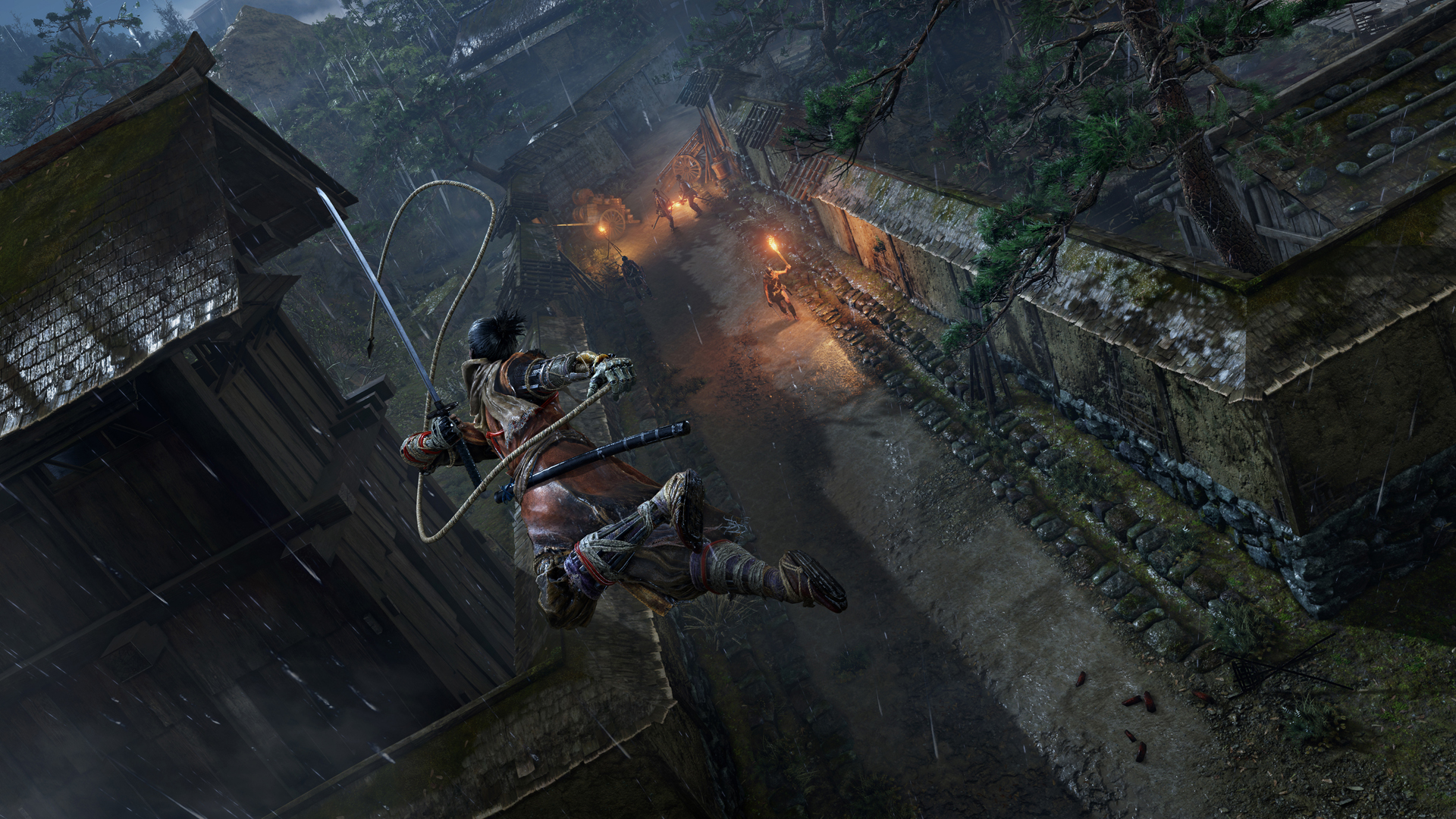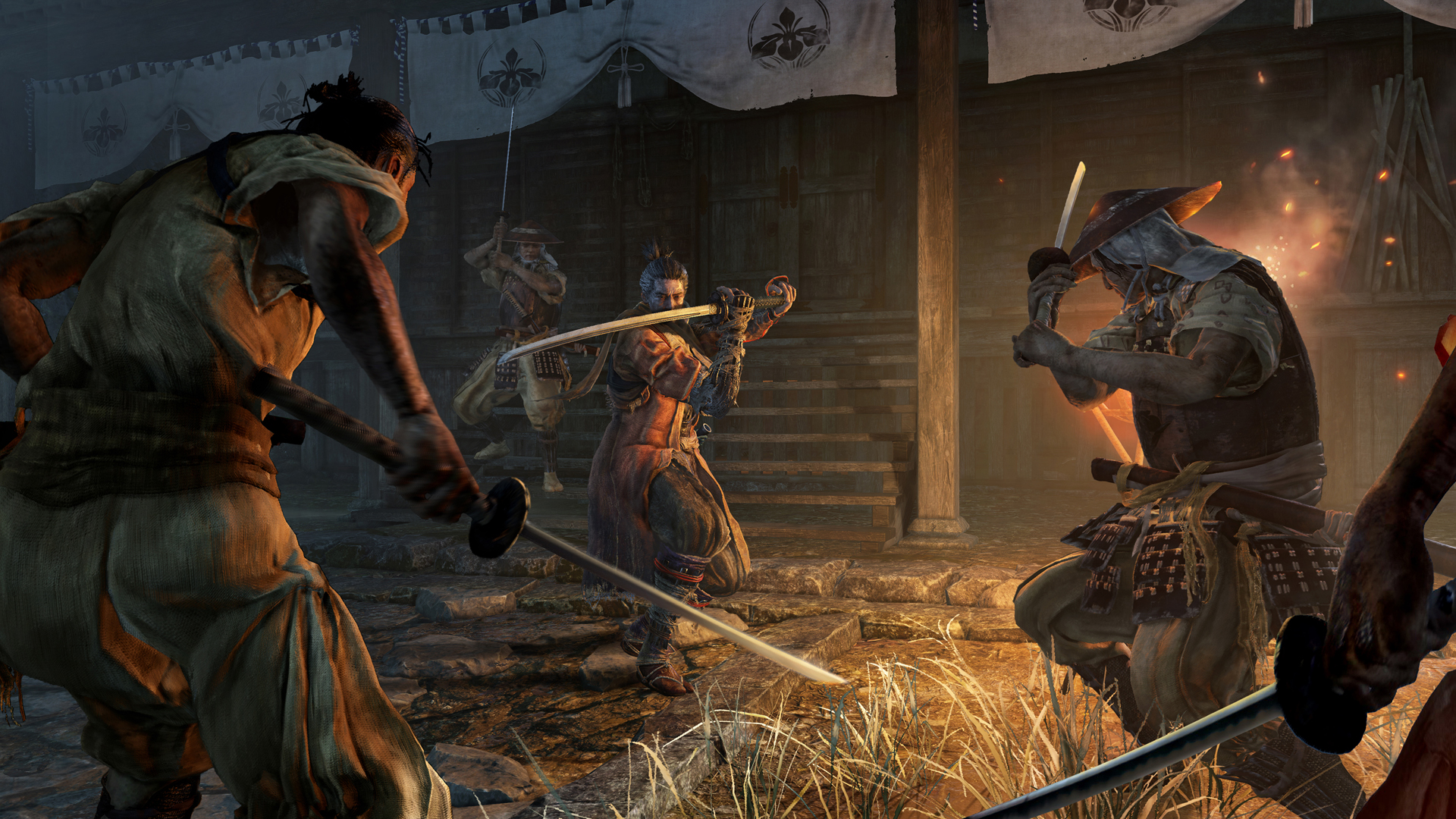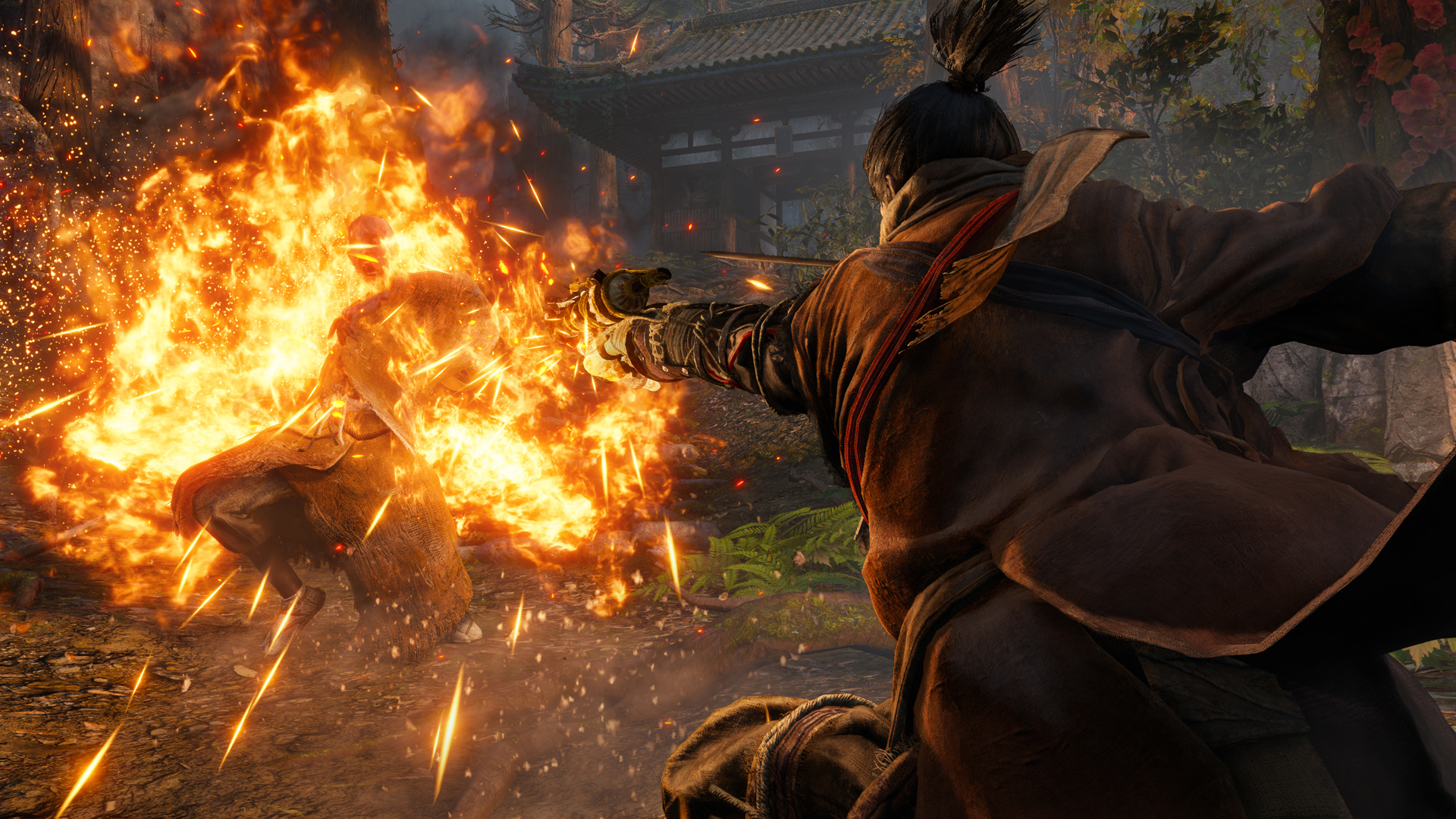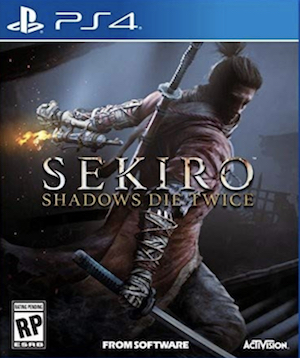
Sekiro: Shadows Die Twice bears a heavy burden of expectation. It has to live up to the excellent standard of quality developers FromSoftware have set for themselves – and really, the entire industry at large – with the likes of Dark Souls and Bloodborne, games that essentially created an entire sub-genre. But at the same time, Sekiro also faces the challenge of emerging from the shadows of the developer’s past works and carving out an identity of its own.
Neither of those tasks is an easy one to accomplish, but impossibly, Sekiro: Shadows Die Twice is a stellar success on both fronts. In its challenging and brutally unforgiving nature that demands absolute mastery, it is very much cut from the same cloth as FromSoftware’s previous games. But it goes about presenting familiar challenges in such fresh new ways, it ends up feeling like an entirely different beast, one that has the same end-goal in mind as its older brethren, but strives to achieve those goals in fundamentally different ways.
"Sekiro goes about presenting familiar challenges in such fresh new ways, it ends up feeling like an entirely different beast, one that has the same end-goal in mind as past FromSoftware games, but strives to achieve those goals in fundamentally different ways."
Where Souls was deliberate and plodding in its approach, which required players to play on the defensive and slowly whittle down the healths of enemies, Sekiro is a furious blaze of gloriously aggressive strikes and slashes. If Bloodborne took the Souls formula ten steps closer to being more aggressive, Sekiro drags it further by another dozen miles. The game demands you to be aggressive even in the face of terrifying aggression, but requires you to do so in a calm, measured, and precisely calculated way- the way a shinobi would.
Sekiro captures the essence of shinobi combat with such perfection, it’s hard to believe that this isn’t something FromSoftware has been doing for years and years. Parrying enemies’ attacks is your bread and butter in this trek through Sengoku Japan- enemies advance on you with surprising pace and devastating strength, all propped up by each of them having a wide range of moves they can whip out at any time. In terms of learning their attack patterns and piecing together how they’re about to strike next at a moment’s notice, Sekiro presents something familiar- but instead of dodging away, now you advance, and raise up your sword at just the right moment to block the attack with a precise riposte.
That clash of steel against steel, and that loud, shrill clang you hear when you pull off the perfect parry- that feels like heaven. And if that parry is the one that leads to a break in your enemy’s posture, giving you just enough time to deal a deadly killing blow to your foe- that feels even better. Every combat encounter in Sekiro is a dance that progressively ramps up its intensity- a locking of eyes, followed by quick blocks and dodges, followed by a flurry of killing blows. It’s fast, slick, stylish, furious, and unbelievably satisfying.
"Every combat encounter in Sekiro is a dance that progressively ramps up its intensity- a locking of eyes, followed by quick blocks and dodges, followed by a flurry of killing blows. It’s fast, slick, stylish, furious, and unbelievably satisfying."
It is also extremely intense, at times almost exhaustingly so, especially when it comes to the bosses and mini-bosses (of which there are multiple dozens in total). Boss design is typically solid and varied, as you would expect from a FromSoftware title, and each and every one of these encounters is a gruellingly intense fight that demands absolute concentration, where even a single slip-up can result in soul-crushing defeat. Multiple deaths during fights against bosses and even some mini-bosses are almost guaranteed, but that one single successful attempt where you manage to perfectly time all your moves and read all incoming attacks- that one victorious attempt results in a swelling sense of adrenaline-fuelled pride that FromSoftware fans will be all too familiar with. After multiple failures, you might feel like you’ve been hitting your head against a brick wall for hours, but that single moment of victory that you’re hungrily chasing feels better than all those defeats put together.
Just as combat is different in Sekiro, so too is the process of dying. For starters, with Souls or Blood Echoes no longer factoring into the game as a mechanic, Sekiro has no corpse runs- but that doesn’t mean there are no penalties to dying. Every time you die, you essentially lose half of everything you have- any currency or experience points you might currently have. There is a blessing that gets activated at rare times to allow you to retain those things even upon dying, but the more you die, the more your chances of getting that blessing are slashed. Dying also has narrative consequences- a disease called Dragonrot festers in the world of Sekiro, and it’s a disease that is mysteriously tied to the protagonist, who’s called Wolf. The more the Wolf dies, the more the disease spreads- the fact that death is something that has consequences not only in gameplay progression, but also in the unfolding of the narrative is something that injects high stakes into every combat encounter.
But there’s a reason Sekiro has the subtitle Shadows Die Twice- because death in this game isn’t always as permanent as you might expect. Thanks to the game’s resurrection mechanic, upon dying, you can bring yourself back to life, which is something that you can do more than once, given you have enough resurrections stored up. While the choice of whether you want to die or be resurrected seldom carries a lot of weight, the choice of when to resurrect, and the pre-battle preparations of how many resurrections you have in store, is something that adds a layer of strategy to combat. Allowing an enemy to believe you’re dead, only to come back to life and catch them unawares with a stealthy Deathblow, or making sure you came into a tough boss encounter prepared with enough resurrections to help you make it through is something that is always a ton of fun to work into your combat strategies.
"The fact that death is something that has consequences not only in gameplay progression, but also in the unfolding of the narrative is something that injects high stakes into every combat encounter."
Also important to combat are your skills (which you unlock with points gained through levelling up) and your Prosthetic Arm. The former can present passive boosts – such as ones that help you with stealth through lower chances of getting detected by enemies – or active ones, such as the ability to counter a certain kind of attack, or learn a new attack yourself. The Prosthetic Arm, on the other hand, can be outfitted with a number of different contraptions, such as a flamethrower, or shurikens, or a giant axe that can break through shields. Prosthetic shinobi tools use up Spirit Emblems, which you can carry only a finite amount of, and need to purchase (or gather within the world itself) should you ever run out. Certain enemy types – or even bosses – can be weaker to certain Prosthetic tools too, so it’s often a good idea to save up their uses for when you really need them. Put together, skills and shinobi tools throw plenty of unique options into the mix, and while the build diversity in Sekiro isn’t nearly as vast as it could be in Souls, it still successfully provides the player with enough options that are quite varied and can be equally viable, given the situation on hand.
But Sekiro doesn’t put all its focus on combat. Stealth is a huge and essential component of the experience. For a huge chunk of the game, you’ll find yourself hiding in tall bushes, hugging walls and peeking around corners, distracting enemies by throwing ceramic shards, creeping under the floors of raised buildings, and using your grapple to exploit the verticality of each of Sekiro’s layered and intricate environments. Being the shinobi that you are, it’s always a better idea to thin out enemies rather than just taking them all head on, not least because when faced by large numbers, you can be easily overwhelmed.
Sleuthing around Sekiro’s excellently designed levels feels great, but the AI of enemies during stealth can be a letdown at times. The game is inconsistent with how and when enemies can become alerted to your presence. Those that are too far away can unexpectedly catch sight of you at times, while often, you’ll find yourself being able to sneak right past enemies even when you should have clearly been in their line of sight. You can also exploit enemy AI during stealth quite easily. Grappling to rooftops, stealth killing an enemy, then grappling back and waiting for enemies to lose sight of you so you can re-enter stealth (which usually doesn’t take that long), and then repeating the entire process to pick off enemies one by one is something that can be easily exploited. This dampens the sense of constant challenge somewhat, and I can’t help but feel that stealth, as a result, ends up feeling noticeably less balanced and polished than actual combat itself. For a game that banks as heavily on stealth as Sekiro does, more polished mechanics on this front would have gone a long way toward crafting a better overall experience.
"Sleuthing around Sekiro’s excellently designed levels feels great, but the AI of enemies during stealth can be a letdown at times."
Something else that Sekiro places a surprising amount of emphasis on is its narrative. Bloodborne and the Souls games were all laden with rich, dense lore, which helped bring their vividly realized settings to life just as much as their strong and eye-popping art design did. In Sekiro, though, the story is told much more directly, thanks to a greater amount of cutscenes (primarily)- but at the same time, in a manner that is very consistent with what you’d expect from a FromSoftware title. NPCs with excesses of personality mutter cryptic sentences to refer to ambiguous events and persons, item descriptions hint at mystic lore, while certain characters and their backstories reveal secrets you could not have expected. Sekiro’s narrative blends the deliberate crypticness of previous FromSoftware games with a more direct storytelling approach very well, and presents a story that is never quite at the forefront, but is always consistently interesting as it brews in the background.
FromSoftware really had no obligation to break the mould the way they have done with Sekiro. If there’s one thing that the high praises and impressive sales of every single one of the Soulsborne games over the past decade has taught us, it’s that it’s not a formula that is wearing thin, nor are people growing tired of it. With Sekiro, though, FromSoftware have gone above and beyond to deliver an experience that adheres to their core philosophies, while changing up everything else. This is a brutally unforgiving game that demands constant attention from its players, but it’s the kind of attention that I have been all too happy to devote. Thanks to its stellar combat and memorable boss fights, Sekiro: Shadows Die Twice is a proud reminder of the fact that FromSoftware doesn’t require the crutch of an established formula to deliver an arresting experience.
This game was reviewed on the PlayStation 4.
Spectacular combat; Brutally and satisfyingly challenging; Intense and excellently designed boss fights; Working the Resurrection mechanic into your combat strategies is a great addition; An interesting narrative that blends FromSoftware's trademark ambiguous style with more direct storytelling very well.
Inconsistent enemy AI during stealth sections; Stealth can be easy to cheese.




















